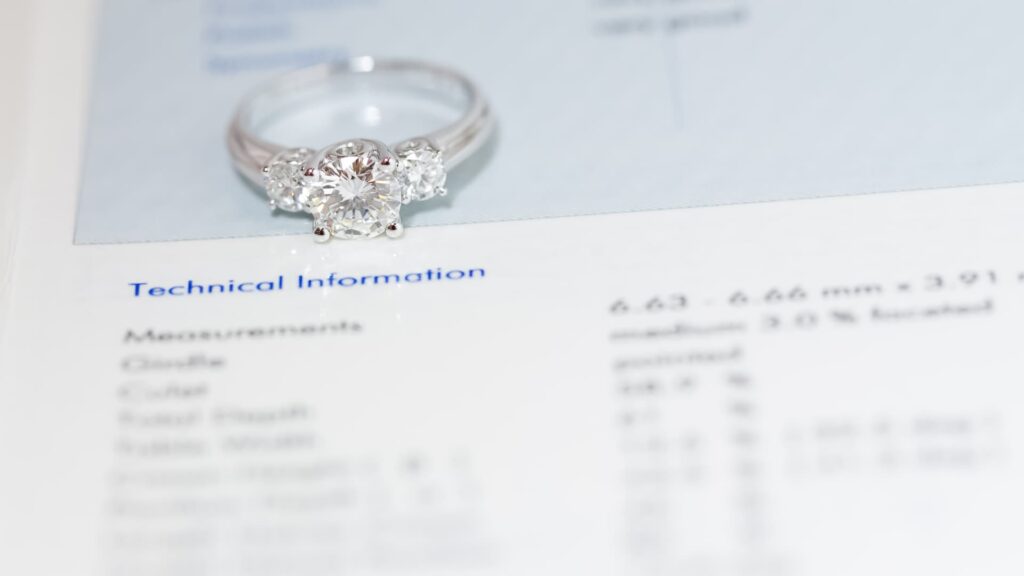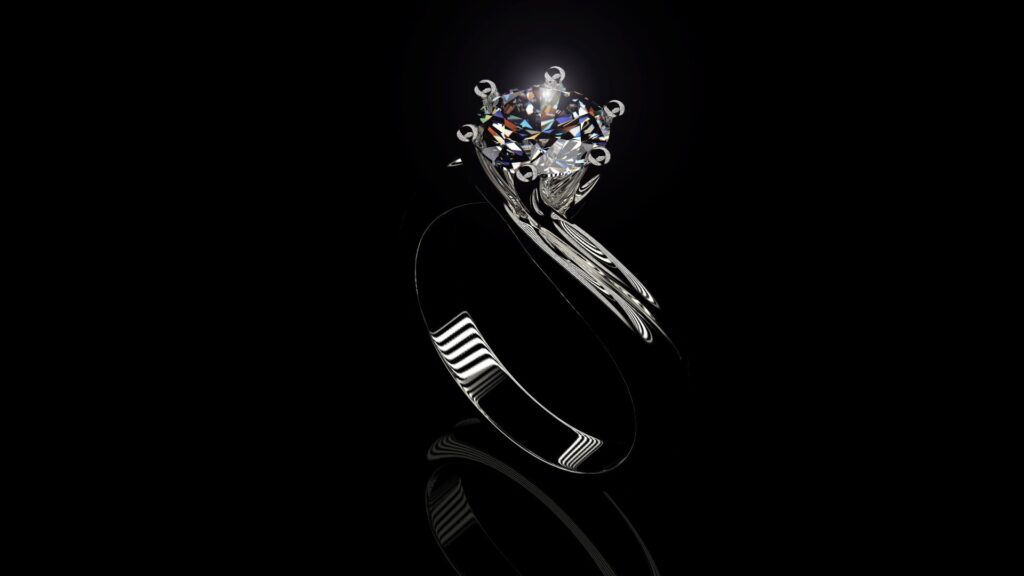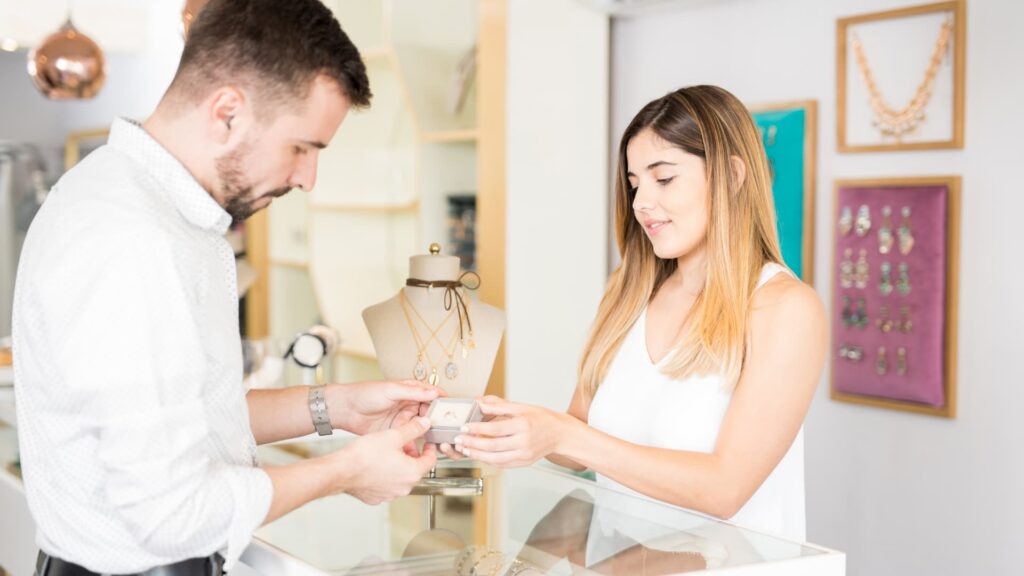Diamond certification is a process in which a diamond is sent to a gem lab to assess its quality. The lab issues a written report or certificate about the diamond and its color, cut quality, clarity, fluorescence, symmetry, and carat weight.
The certificate will help you know that the diamond you intend to purchase is tested by a gem lab and confirmed to be a natural diamond. If you want to sell the diamond, then having a diamond certificate from a reputed lab will give you the best resale value that you can get.
Diamond certification is quite essential. I strongly advise you to buy a certified diamond from reputed Gemological laboratories. Some local jewelers may justify to you that a diamond certificate is unnecessary and convince you to purchase a non-certified diamond.
By doing this, the jeweler might be able to sell you diamonds of a lower grade and make a huge profit off of you. Reputed diamond dealers will always share with you a certificate from the best Gemological laboratories.
The Gem Certification & Assurance Lab (GCAL) and Gemological Institute of America (GIA) are the two foremost entities that issue diamond certifications in the world. In this article, I will discuss the differences between the GCAL vs. GIA, and which one can give you a more valuable, better certification.
If you are a diamond enthusiast, this is going to be riveting information. Read on!

What is GCAL?
The Gem Certification and Assurance Lab (GCAL) is one of the most reputed diamond grading labs in the world. A certificate from this lab will ensure that you are investing in a stone whose value is commensurate with what the dealer is charging you.
The main aim of this lab is to test and analyze the diamonds and then issue the report depending on the quality.
History of GCAL Diamonds
GCAL was started by Dr. Philip W. West and Dr. Mannie D. Paine in 1978. They opened a 2,500-square-foot lab at that time known as West Paine Laboratories in Louisiana.
The lab kept on growing in both reputation and scale, and in the year 2000, it established itself in New York. It then expanded into a 22,000 square feet entity which we know as GCAL today.
The GCAL is an expert in analyzing gemstones and has a special reputation in grading and certification of diamonds. It grades not only loose diamonds but also precious metals, pearls, and various colored stones.
The testing process of GCAL involves organic, inorganic, radiochemistry, and other major methods to determine the level of contaminants in the stone. It employs more than 70 scientists, all of whom are experts in analyzing and grading diamonds.
Anatomy of a GCAL Certificate
A GCAL Certificate is broken down into three parts. You will find a gem print and laser inscription with a serial number in the first panel.
The middle panel consists of 4 Cs of a diamond: carat weight, color, clarity, and cut. These qualities will strongly impact the price of the diamond. The higher the grade, the more expensive the diamond is.
Related article: What Is a Certified Diamond: Certificates Explained
Color Grade
For instance, if a diamond has an F color grade, it will cost you more than an I color grade if all other qualities are identical. This is because the F color grade diamond is colorless while an I color diamond has yellowish tints on it.

Cut
The cut category includes the shape, measurements, polish, symmetry, culet size, girdle thickness, table %, depth %, and polish.
Photomicrographic
The second panel also lists photomicrographic, where actual images of the crown and pavilion of the natural diamond are photographed at magnification up to 10x.
Light Performance
The third panel in the report details the light performance of a diamond. The majority of diamond buyers give importance to the brilliance of the stone.
The optimal light performance section shows how much light will return (white areas) and the diamond’s loss (dark blue areas).
The optical symmetry image will provide information regarding facet alignment.
Proportion Diagram
A section at the bottom of the third panel is called a proportion diagram. It will illustrate the actual dimensions of the diamond.
What is GIA?
The Gemological Institute of America is perhaps the most reputed entity for grading diamonds. The story of GIA dates back to 1920 when Robert M. Shipley was enjoying a successful career in the jewelry industry.
After a few years, he realized that he did not have sufficient expertise with jewelry and precious stones. He travelled to Europe and completed the Great Britain National Association of Goldsmiths Gemological correspondence course.
Later, Shipley returned to Los Angeles and launched a course in Gemology to train and certify other jewelers on what he had learned. The jewelers who got certified by him formed the national guild of jewelers. The first GIA laboratory was established in Los Angeles in 1931.
The GIA provides a report for various gems, including:
- Natural diamonds
- Natural colored diamonds
- Colored stones
Anatomy of a GIA Certificate
Experienced gemologists analyze diamonds to determine whether they are lab-grown or natural. They then provide a certificate that will help you know the quality of the diamond you intend to purchase.
The left side panel on the certificate shows the GIA report number, shape and cutting style, and measurements of the diamond. You will find grading results below like carat weight, color, clarity, cut grade, polish, symmetry, and fluorescence.
The color and clarity of the diamond are graded on a large scale because it’s difficult for the naked eye to distinguish the difference between the two grades.
The higher the grade, the more expensive the diamond will be. For instance, a diamond with high clarity grade will be costlier than a diamond with low clarity grade despite all other characteristics remaining the same.
On the right side of the certificate, you will find diagrams related to diamonds’ clarity characteristics and proportions. Reputed online jewellers like James Allen and the Blue Nile usually display GIA reports and diamonds.
What Are The Differences Between GCAL vs. GIA?
Both GCAL and GIA share many similarities in operation and services. But there are some differences between a GCAL and GIA diamond certificate.
1. GCAL Grades More Lab-Grown Diamonds
The Gemological Institute of America (GIA) started grading lab-grown diamonds in 2007. Before that, various entities like GCAL were already grading lab-grown diamonds.
These diamonds have almost the same physical and chemical characteristics as those natural diamonds, yet are less expensive.
If you buy a GCAL certified lab-grown diamond, you will receive four reports:
- General certificate
- A certificate with a heart and arrow analysis
- Express certificate
- Jewelry card
GCAL lab-grown diamonds reports are more comprehensive as compared to GIA. The certificate includes carat weight, cut, girdle thickness, culet size, color, and clarity of the diamond.
Moreover, the third panel includes optical brilliance analysis, optical symmetry analysis, and proportion diagram. The proportion diagram will illustrate the actual dimension of a lab-grown diamond.
However, the lab-grown diamond certificate of both entities includes the process of the formation of diamonds. The most popular process is Chemical Vapor Deposition (CVD) and high-pressure treatment.
2. GCAL Grades The Inclusions in Diamonds More Extensively
Diamonds are formed when carbon deposits found deep inside the earth are treated with high pressure and temperature. It may take a few months, years, or millions to form a diamond.
While forming a diamond, certain inclusions or impurities may stay in it. The higher the inclusions, the lesser the price. But everyone wants to buy a flawless diamond, or at least so that inclusions cannot be seen by the naked eye.
The GIA diamond certificate will show clarity characteristics with images. The image shows the top and bottom view of the diamond and the position of inclusions in it. Symbols designate the inclusions, and the meaning of the symbols are written below. It helps you know which inclusions or impurities are present and where they are positioned in a diamond.
Now, if I talk about GCAL, it includes a clarity section in the middle of the panel. You will find the clarity grade written, which will help you know whether it is entirely flawless or has inclusions, but that cannot be seen by the naked eye.
Below the clarity grade, you find identifying characteristics and location. For instance, you may find crystal feather inclusions in the table and lower girdle. It will help you know the size and exact location of inclusions so that you can decide whether the diamond is right for you.
3. GCAL Offers Certificates With Guarantee
Have you ever looked at a reputed diamond certificate in detail? On most certificates, you will find a small fine print that says that the entity is not responsible for errors in judgment.
For instance, if you purchased a D color diamond and it turned into an E or F color grade after a few days, the lab is not responsible for it. The court has even ordered that labs are not responsible for it.
But GCAL thinks that these reports are unethical and call such documents reports and not certificates. It is because true certificates carry responsibility for the lab which issued them.
GCAL is the only lab in the world that guarantees the color and clarity grade in the form of writing. It introduced a money-back guarantee in 2000, which ensures you the accuracy of cut quality, color, clarity grade, and carat weight of the diamond you intend to purchase.
A GIA certificate lists all the characteristics of the diamond after it is graded, tested, and analyzed by experienced gemologists in the GIA lab. However, if the lab provides you with a D color grade and it changes after purchasing, the lab is not responsible for it.
4. GCAL Certifications Include Diamond Image
You can see the actual image of the diamond on a GCAL certificate. In the middle panel, you can see a section called photomicrographs. Below, you will see images of the crown (top) and pavilion (bottom) of the diamond. They are photographed at 10x magnification, which will help you understand the details of cut and symmetry in facets.
But in the GIA report, you will not find a section on photomicrographs, so you cannot see the magnifying images of the diamond.
5. GIA Certificates Are More Popular Compared to GCAL
Both GIA and GCAL are renowned lab entities. But most of the popular diamond retailers like James Allen and Blue Nile send most of their diamonds to GIA rather than GCAL.
6. Market Share
GCAL is a reputed entity but has a lower market share compared to GIA.
How Do GCAL and GIA Certificates Affect the Price of Diamond?
The same diamond can sell for a different price depending on the entity which has graded it. Two factors impact the price of the diamond. The first factor is based on grades. For instance, let us assume a diamond that has the following grades.
- Carat weight – 1
- Cut – Excellent
- Color – E
- Clarity – VVS1
The same diamond is graded by another entity as follows.
- Carat weight – 1
- Cut – Very good
- Color – F
- Clarity – VVS2
In the first case, the gemological lab gave a higher grade to the diamond. So, it will naturally cost you more than the second one. It illustrates the importance of the lab in grading diamonds.
Final Thoughts
A diamond is quite expensive. So, you need to be assured that you are getting a good diamond for your money.
Both GCAL and GIA are good institutions that grade diamonds. However, both entities have pros and cons. Thank you for reading, and I hope this answers most of your queries about the differences between GCAL vs. GIA!
Related articles:
Why Are Diamonds So Hard?
I vs J Color Diamonds Compared
VS1 vs. VVS2 Diamond Compared






